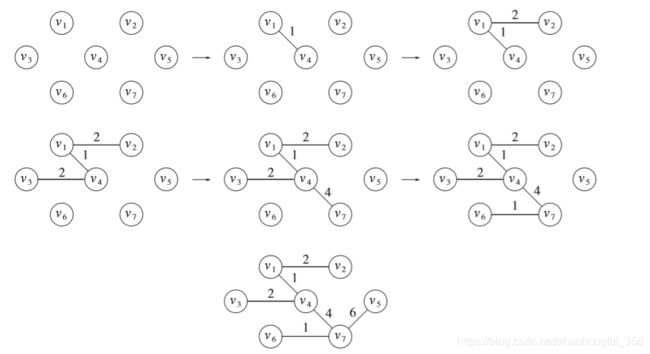复旦大学961-数据结构-第五章-图(三)最小生成树基本概念,Prim算法,Kruskal算法
961全部内容链接
文章目录
- 最小生成树的概念
- 带权图ADT及其实现
- Prim算法
- Kruskal算法
最小生成树的概念
首先,最小生成树是针对①连通图和②带权图的。生成树就是对一个连通图砍掉一些边,然后将这个图变成一个树。而最小生成树(Minimum-Spanning-Tree,MST)就是,如何砍边,然后能让这棵树的权值最小。
最小生成树具有以下特点:
- 最小生成树不唯一。一个图可以可能对应多个最小生成树
- 最小生成树的权值唯一。虽然树不唯一,但是他们的权值一定是唯一的,且是最小的。
- 最小生成树的边数等于顶点数减1。这是树的性质
带权图ADT及其实现
public interface WeightedGraph<VertexType> extends Graph<VertexType> {
int getEdgeWeight(VertexType x, VertexType y); // 获取(x,y)边的权值
void addEdge(VertexType x, VertexType y, int weight); // 插入边 或 (x,y)
}
带权图的ADT继承自普通图,多了获取边的权值。增添边时需要多传一个权值的参数。
具体实现如下:
// 邻接矩阵无向带权图
public class AdjacencyMatrixUndirectedWeightedGraph<VertexType>
extends AdjacencyMatrixUndirectedGraph<VertexType>
implements WeightedGraph<VertexType> {
public AdjacencyMatrixUndirectedWeightedGraph(int maxVertexNum) {
super(maxVertexNum);
}
@Override
public int getEdgeWeight(VertexType x, VertexType y) {
return edges[findIndex(x)][findIndex(y)];
}
@Override
public void addEdge(VertexType x, VertexType y, int weight) {
int xIndex = findIndex(x);
int yIndex = findIndex(y);
edges[xIndex][yIndex] = weight; // 因为是无向图,所以 (x,y)和(y,x)都要为weight
edges[yIndex][xIndex] = weight;
}
}
这是邻接矩阵方式实现的无向带权图。也是继承了之前的无权图。具体的无权图代码可以看之前的章节。
Prim算法
prim算法是用于构造最小生成树的,大致思想如下:
- 首先树中选取一个顶点,一般取第一个。将其加到树T(最开始为空树)中
- 然后距离树T最近的一个顶点。最开始只有一个顶点,所以就是选取距离该顶点最近的顶点。
- 将距离树最近的节点加入树中
- 循环2,3步骤,直到所有的顶点都加入到树中。
public static WeightedGraph prim(WeightedGraph graph) {
// 使用带权图的形式存储树
WeightedGraph resultGraph = new AdjacencyMatrixUndirectedWeightedGraph(graph.getVertexNumber());
Object initVertex = graph.getVertexByIndex(0); // 选择第一个顶点作为起始顶点
resultGraph.insertVertex(initVertex); // 将起始节点插入树
while (resultGraph.getVertexNumber() < graph.getVertexNumber()) {
// 若树中的节点小于图中的节点,则说明还有节点没有加入树中
Object[] treeVertexes = resultGraph.getVertexes(); // 获取当前树中的所有节点
Object[] closetVertex = findClosestVertex(treeVertexes, graph); // 找出图中距离该树最近的一个节点,并返回树的节点和图的节点
Object x = closetVertex[0]; // x为树的节点,y为图中的节点。意思是:图中的y节点距离树中的x节点最近
Object y = closetVertex[1];
resultGraph.insertVertex(y); // 将y节点插入树
resultGraph.addEdge(x, y, graph.getEdgeWeight(x, y)); // 增加(x,y)这条边,权值就是图中(x,y)边的权值
}
return resultGraph;
}
// 找出图中距离这棵树最近的节点,并返回树的节点和图的节点
private static Object[] findClosestVertex(Object[] treeVertexes, WeightedGraph graph) {
HashSet treeVertexesSet = new HashSet(Arrays.asList(treeVertexes)); // 将树节点变成HashSet用于比较是否该节点在树中
int minWeight = Integer.MAX_VALUE; // 初始化最小权值为无穷
Object treeVertex = null; // 图中的closestVertex节点距离树中的treeVertex节点最近
Object closestVertex = null;
for (int i = 0; i < treeVertexes.length; i++) {
// 遍历树的所有节点,找出距离该树最近的节点
Object[] neighbors = graph.neighbors(treeVertexes[i]); // 获取树节点i的所有邻接节点
for (int j = 0; j < neighbors.length; j++) {
// 遍历所有i的邻接节点,找出最小的那个
if (!treeVertexesSet.contains(neighbors[j]) && // 若该邻接节点不是树中的节点,且距离不为0(定义0为不可达),并且该权值小于最小权值
graph.getEdgeWeight(treeVertexes[i], neighbors[j]) > 0 &&
graph.getEdgeWeight(treeVertexes[i], neighbors[j]) < minWeight) {
minWeight = graph.getEdgeWeight(treeVertexes[i], neighbors[j]); // 满足if条件,则更改最小权值
treeVertex = treeVertexes[i]; // 记录当前权值最小的两个节点。
closestVertex = neighbors[j];
}
}
}
return new Object[]{
treeVertex, closestVertex};
}
复杂度分析(王道解释):
Prim算法的时间复杂度为O(|V|^2),不依赖于|E|,因此它适合求解边稠密的图的最小生成树。虽然采用其他方法能改进Prim算法的时间复杂度,但增加了实现的复杂性。
Kruskal算法
这个算法也是求最小生成树的,不过它是依赖边的。大致思想如下:
- 先初始化树所有的节点。没有任何边。
- 然后从图中选取一条权值最小的边,连接树中相应的节点。
- 重复2操作,若边使得树形成了回路,则舍弃该条边。然后继续2
- 直到边的数量=节点数量-1时,即连通分量数为1,查找完成。
举例,这是Kruskal算法的过程。

算法需要解决的两个关键问题:
- 如何找出当前最小的边?这个简单,只需对当前所有边进行排序,然后从小到大依次取就行了。更好的方式是使用最小堆来每次选择一个最小的元素。
- 如何判断加入当前边后,树是否形成了回路?如上图,最开始为7个节点,可以将这七个节点看成是7个连通分量,加入一条表。连通分量就会减1,当连通分量数量为1时,则构建完成。在这个过程中,若加入的边的两个节点属于同一个连通分量,则一定会形成回路。若两个节点属于不同的连通分量,则一定不会形成回路。
Java代码如下:
public static WeightedGraph kruskal(WeightedGraph graph) {
WeightedGraph treeGraph = new AdjacencyMatrixUndirectedWeightedGraph(graph.getVertexNumber()); // 使用带全图的方式存储最小生成树
for (int i = 0; i < graph.getVertexNumber(); i++) {
// 初始化树中的节点
treeGraph.insertVertex(graph.getVertexByIndex(i));
}
Union union = new Union(Arrays.asList(treeGraph.getVertexes())); // 将所有节点加入并查集
int n = treeGraph.getVertexNumber(); // 记录当前连通分量的数量
BinaryHeap heapEdge = new BinaryHeap(graph.getEdges()); // 使用图的边构建一个最小堆
while (n > 1) {
// 如果连通分量的数量为1时,说明最小生成树已经生成。
WeightedGraph.Edge edge = (WeightedGraph.Edge) heapEdge.deleteMin(); // 从最小堆中拿出最小的那条边
if (union.isConnected(edge.vertex1, edge.vertex2)) continue; // 判断这条边的两个节点是否属于同一个连通分量,即加入该条边后是否会形成回路,如果会,则舍弃这条边
union.union(edge.vertex1, edge.vertex2); // 将这条边的两个节点合并成到一个连通分量中
treeGraph.addEdge(edge.vertex1, edge.vertex2, edge.weight); // 将树中的这两个节点连接起来
n--; // 连通分量的数量-1
}
return treeGraph;
}
这个算法不长,但是用到了之前章节学到的两个重要的数据结构。一个是并查集(961大纲中没有)。另一个是堆。其中堆的代码在之前就有。
这里给出并查集的Java实现:
// 并查集
public class Union<AnyType> {
private Map<AnyType/*当前节点*/, AnyType/*当前节点的父节点*/> map; // 存储并查集
public Union(Collection<AnyType> collection) {
map = new HashMap<>();
// 初始化并查集
for (AnyType item: collection) {
map.put(item, item); // 初始条件下,定义各个元素的父节点就是它自身,即该集合的根节点就是它自己
}
}
// 将并查集中的两个不相连的元素x,y合并成一个
public void union(AnyType x, AnyType y) {
AnyType xRoot = findRoot(x); // 找出x所在集合的根节点
AnyType yRoot = findRoot(y); // 找出y所在集合的根节点
map.put(yRoot, xRoot); // 将y所在集合的根节点连接到x的根节点上
}
// 判断x,y两个节点是否连接
public boolean isConnected(AnyType x, AnyType y) {
return findRoot(x) == findRoot(y); // 如果x,y同属于一个根节点,则说明他们两个互相连接
}
// 找出x节点的根节点
private AnyType findRoot(AnyType x) {
// 如果自身等于自身,说明找到根节点,否则就将x赋值为它的父节点。
while (!map.get(x).equals(x)) {
x = map.get(x);
}
return x;
}
}
因为kruskal算法需要获取到图的所有边,所以WeightEdge中增加了一个抽象方法:
public interface WeightedGraph<VertexType> extends Graph<VertexType> {
static class Edge implements Comparable<Edge> {
public int weight; // 边的权值
public Object vertex1; // 变得
public Object vertex2; // 该边连接的两个节点
public Edge(int theWeight, Object theVertex1, Object theVertex2) {
this.weight = theWeight;
this.vertex1 = theVertex1;
this.vertex2 = theVertex2;
}
@Override
public int compareTo(Edge o) {
return Integer.compare(weight, o.weight);
}
}
List<Edge> getEdges(); // 返回所有的边
int getEdgeWeight(VertexType x, VertexType y); // 获取(x,y)边的权值
void addEdge(VertexType x, VertexType y, int weight); // 插入边 或 (x,y)
}
邻接矩阵的具体实现为:
public List<Edge> getEdges() {
ArrayList<Edge> edgeList = new ArrayList<>();
for (int i = 0; i < edges.length; i++) {
for (int j = i+1; j < edges[i].length; j++) {
if (edges[i][j] != 0) {
edgeList.add(new Edge(edges[i][j], vertexes[i], vertexes[j]));
}
}
}
return edgeList;
}
复杂度分析(王道):
通常在Kruskal算法中,使用堆来存放边的集合,因此每次选择最小权值的边只需要O(log|E|)的时间。由于总共有|E|条边,所以总时间复杂度为O(|E|log|E|)。所以这个适合稀疏图

